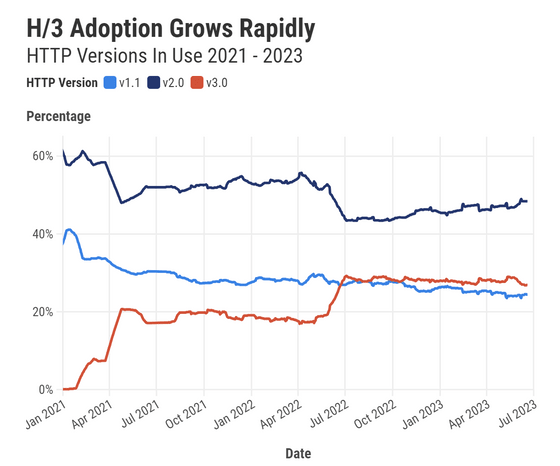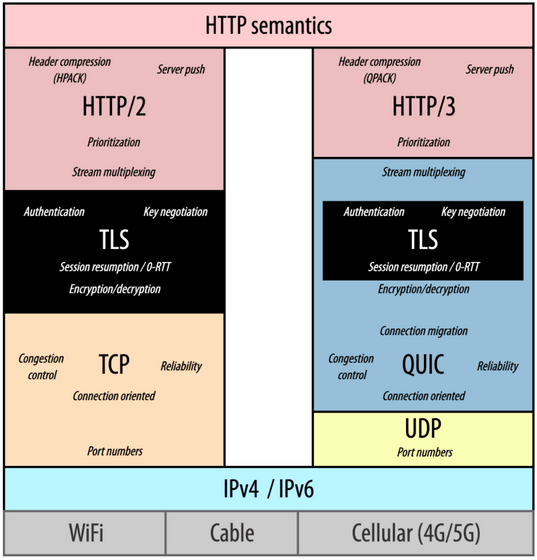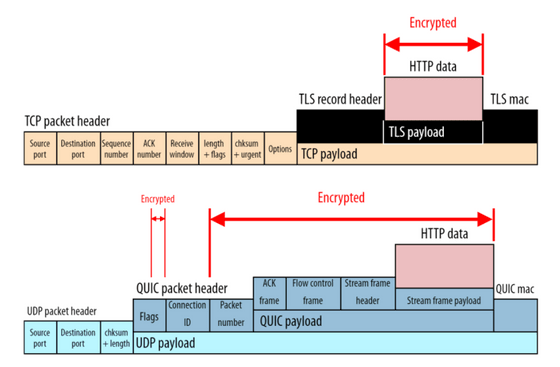Why has HTTP/3 become so popular and what are its advantages?

Since
Why HTTP/3 is eating the world | APNIC Blog
https://blog.apnic.net/2023/09/25/why-http-3-is-eating-the-world/
Since large companies such as Google and Meta have adopted HTTP/3, HTTP/3 is used for many communications, including reading blog articles from GIGAZINE and APNIC. The results of investigating the changes in each version of HTTP used for communication are shown in the figure below. You can see that the usage rate of 'v3.0' indicated by the red line is increasing between 2021 and 2022.

Network protocols such as HTTP/3 determine how data is communicated between two entities on the network, such as a smartphone and a web server. Because many different companies build software for the web, protocols need to be standardized so that all software can communicate with each other.
At this time, instead of using a single protocol, we increase flexibility and reusability by using a combination of various protocols with different rules. By doing this, you can use exactly the same HTTP rules even if the base route such as Wi-Fi, cable, mobile line, etc. is different.

Many of the protocols that support the Internet were standardized from the 1980s to the 1990s, so today there are protocols whose surrounding environments have changed significantly. One of them is 'TCP (Transmission Control Protocol)'.
HTTP/1.1 and HTTP/2 use TCP for communication. In other words, before exchanging HTTP requests and responses, a TCP connection must be established between the client and server. However, TCP is a protocol designed with the exchange of single files in mind, and has problems such as inefficiency when displaying modern websites made up of hundreds of individual files. had.
Many devices on the Internet implement TCP on their own, including smartphones, laptops, desktop PCs, servers, and many middlewares such as routers, firewalls, load balancers, etc., so even if you update the TCP rules, it will not work in practice. It will take years for it to appear on devices. Therefore, rather than updating TCP, we decided to create a new protocol.
This is how a new product, ``QUIC'', was introduced. QUIC is highly integrated with

Broadening the scope of encryption not only has general security and privacy benefits, but also prevents middleware between the client and server from accessing the metadata being encrypted, making it easier to use encryption in the future. There is also the advantage that even if it becomes necessary to upgrade the QUIC protocol, you only need to update the client and server parts.
Furthermore, QUIC has functions such as amplification prevention and RETRY packets, improves defense performance against DDoS attacks, and has significantly improved efficiency and performance than TCP. In addition to reducing the number of communications required for handshaking to two, QUIC solves the '

Initially, it was considered to replace TCP with QUIC and use HTTP/2 as an overlying protocol, but the differences between TCP and QUIC were too large, so a new HTTP version exclusively for QUIC was created called 'HTTP/2'. /3' has been created.
Therefore, the only difference between HTTP/3 and HTTP/2 is 'QUIC or TCP.' However, QUIC has improved web page loading speed and performance when streaming movies compared to TCP, and major IT companies that are sensitive to performance differences have started using it one after another, so HTTP/3 This means that it has spread rapidly.
Related Posts:
in Software, Web Service, Posted by log1d_ts







